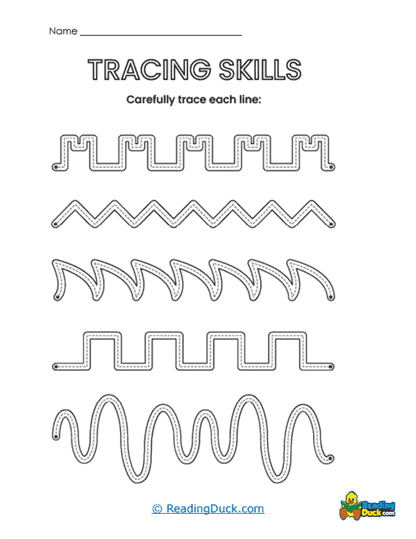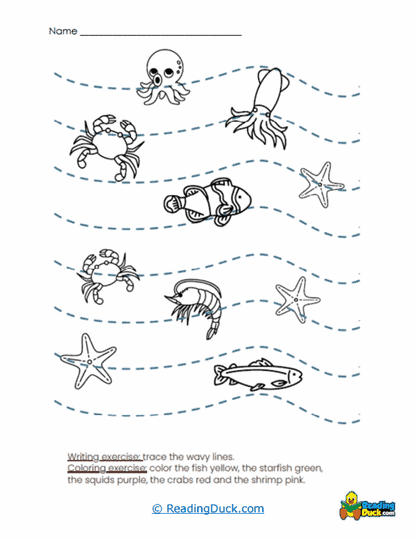Path Tracing Worksheets
About Our Path Tracing Worksheets
Our Path Tracing Worksheets collection is designed to help young learners develop essential fine motor skills and early writing abilities through a variety of tracing activities. These worksheets are perfect for pre-kindergarten through first-grade students, providing engaging exercises that build the foundational skills necessary for writing and other precision tasks.
The collection features a wide range of tracing paths, from simple straight lines to more complex shapes like spirals and zigzags, ensuring that students of all skill levels can find activities that challenge and inspire them. Available in easy-to-download PDF format, these worksheets are a versatile resource for both classroom and home use.
What are Path Tracing Worksheets?
Path Tracing Worksheets are educational tools that focus on developing young children’s fine motor control, hand-eye coordination, and prewriting skills. These worksheets guide children through tracing various types of lines and patterns, helping them gain control over their hand movements and prepare for writing. The activities within this collection are designed to be fun, engaging, and progressively challenging.
Here’s what these worksheets typically include:
- Basic Line Tracing: These worksheets feature a variety of lines—straight, wavy, curved, and zigzag—that children can trace. Each worksheet may focus on a single type of stroke or offer a mix of different lines to practice multiple skills in one session. Tracing these lines helps children build the muscle memory needed for writing letters and numbers.
- Theme-Based Tracing: Some worksheets combine tracing with other engaging activities, such as tracing wavy lines while coloring in fishes or connecting penguins to their igloos through various traced paths. These themed activities make tracing more exciting and provide a context that enhances comprehension and retention.
- Shape and Pattern Tracing: Activities that involve tracing spirals, triangle paths, or collapsing squares challenge children to follow more complex patterns, helping them develop spatial awareness and problem-solving skills. These exercises are particularly useful for introducing geometric concepts in a hands-on way.
- Path-Finding Tracing: Worksheets where children help vehicles find their way across various paths by tracing from one point to another (e.g., from a red circle to a blue circle) encourage not only fine motor control but also logical thinking as students must navigate the correct route.
These worksheets are designed to be both educational and enjoyable, providing young learners with the practice they need to become confident in their prewriting abilities.
How Educators Can Use Path Tracing Worksheets in the Classroom
Path Tracing Worksheets can be seamlessly integrated into classroom activities to enhance learning in a variety of ways. These worksheets are versatile tools that can be used on their own or as part of a larger lesson plan, making them ideal for a range of educational settings.
- Introducing Tracing Activities: Educators can introduce tracing activities by starting with basic line tracing worksheets. Begin with straight lines and gradually move on to more complex patterns like zigzags and curves. This approach allows children to build their skills progressively, ensuring they gain confidence as they master each type of line.
- Incorporating into Thematic Lessons: These worksheets can be tied into broader thematic lessons. For example, during a unit on marine life, teachers can use the worksheet that involves tracing wavy lines and coloring in fishes. This not only reinforces the tracing skill but also ties in with the theme, making the activity more meaningful and engaging for students.
- Group and Partner Activities: To encourage collaboration and communication, teachers can turn tracing activities into group or partner exercises. For instance, pairs of students could work together to trace different sections of a path and then compare their results. This not only makes the activity more social but also allows children to learn from one another.
- Supplementary Challenges: For students who are ready for more advanced work, educators can add supplementary challenges. After completing a tracing worksheet, students could be asked to replicate the path without the guide or to create their own paths for their classmates to trace. This extension activity reinforces the skill and encourages creativity.
- Cross-Curricular Integration: Path tracing worksheets can be integrated into other subjects to create a multidisciplinary learning experience. For example, in a math lesson on shapes, teachers can use worksheets that involve tracing geometric patterns like spirals and triangles. This not only reinforces the concept being taught but also gives students additional practice in fine motor control.
- Interactive Storytelling: Educators can make tracing activities more engaging by incorporating them into storytelling sessions. For example, after reading a story about animals, students can be given a worksheet that involves tracing paths to connect animals to their habitats. This approach not only reinforces the tracing skill but also ties the activity into the narrative, making it more relevant and memorable for students.
The Importance of Developing Tracing Skills
The skills honed through Path Tracing Worksheets are foundational for a child’s development and play a crucial role in their readiness for writing and other academic tasks. Tracing activities provide more than just fine motor practice—they also support cognitive development, problem-solving, and attention to detail.
- Fine Motor Skill Development: Tracing requires precise hand movements and control, which are essential for writing. By regularly practicing tracing, children strengthen the small muscles in their hands and fingers, which are necessary for holding a pencil correctly and forming letters and numbers with accuracy.
- Hand-Eye Coordination: Tracing lines from one point to another helps children improve their hand-eye coordination, which is critical for all sorts of tasks, from writing to playing sports. As they learn to guide their hands in alignment with their visual input, they become more adept at tasks that require precision and coordination.
- Spatial Awareness and Problem-Solving: Tracing activities that involve following a path or connecting shapes help children develop spatial awareness—the ability to understand how objects relate to each other in space. This skill is vital for understanding geometry and other mathematical concepts. Additionally, path-finding activities require children to think critically and solve problems as they determine the correct route to trace.
- Attention and Focus: Completing a tracing worksheet requires concentration and attention to detail. These activities help children develop the ability to focus on a task, which is essential for success in school. The repetitive nature of tracing also fosters perseverance, as children learn that practice leads to improvement.
By regularly practicing tracing skills, young learners build a strong foundation for academic success. These skills not only prepare them for writing but also support their overall cognitive and motor development, ensuring they are well-equipped to tackle more complex tasks as they progress in their education.
Path Tracing Worksheets: A Fun and Effective Way to Build Pre-Writing Skills
In summary, our Path Tracing Worksheets collection is an essential resource for helping young learners develop the fine motor skills, hand-eye coordination, and spatial awareness necessary for early academic success. These activities are perfect for pre-kindergarten through first-grade students, offering a wide range of tracing exercises that cater to different skill levels and learning styles.
Whether used as standalone activities or integrated into broader lesson plans, these worksheets provide a fun and effective way to build the foundational skills needed for writing and other precision tasks. By incorporating these worksheets into your teaching, you provide your students with the tools they need to succeed in their educational journey, ensuring they are prepared for the challenges ahead.









